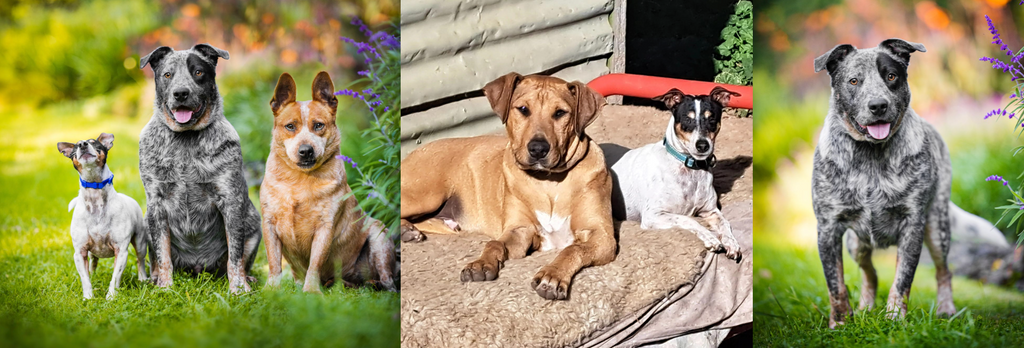
FAQ's On Raw Feeding and Changing Diet
Making the switch to a fresh diet is a big change for your dog and hopefully everything goes smoothly.
Sometimes you will encounter hiccups along the way but don’t worry, it’s fairly normal and there are almost always ways to overcome them.

1) Upset tummy or runny poos
If your dog has been digesting one kind
of food for a long time and we suddenly switch to a completely new food, it can be a bit of a shock to the system . The best way to combat or avoid this
is to introduce new foods slowly, and transition across to their new meal plan over a week or so, reducing the old food and gradually increasing the portion of new food . Adding organ meats last is a good idea, as they can trigger an upset tum .
Fortunately, the gut microbiome adapts very quickly and this should resolve itself in no time . You can also try a course of probiotics, as well as digestive enzymes to help with the transition period .
2) They’re not losing weight
If your dog has made the transition to a fresh diet, but the pounds aren’t budging, give it time . If they haven’t lost any weight in 3-4 weeks, you probably need to reduce their portions . Reduce by 10% and wait another 2-3 weeks . You can also increase their exercise if appropriate, and make
sure you’re not accidentally overfeeding treats or snacks . If you are feeding more than 10% of the diet at treats, wind it back.
And don’t just go by the scale; if they are gaining muscle mass and losing fat, their “weight” may not change.
Use a body condition chart and monitor their physique rather than the number on the scale.
If you have done all of this and they’re still not losing weight, a vet check may be in order to make sure there isn’t an underlying health issue .
3) They don’t like their new food
This can be confusing, but again it’s important to remember this is a major change from what your dog is used to . Most dogs will absolutely love the switch to fresh foods but if you find yours is a little hesitant, you can try a few of the following tricks:
-
Limit the feeding window . If your dog doesn’t eat their food, take it away and try again in a few hours or at their next mealtime . Most dogs will eat when they get hungry and realise no other food is coming .
-
Try lightly cooking the meat to begin with as this will
release aromas and make the food more appealing . If you plan to feed raw, gradually reduce the cooking time until you are no longer cooking it and just serve the food warm instead .
-
Try offering new foods by hand . This is a delicate balance because you don’t want to create a monster that will only eat from your hand, but in the very early days it can help your dog to trust that this strange new food is safe to eat .
-
Try to find a food your dog does like and get them started with this, then gradually add small amounts of new foods . This can also be done by adding something yummy to their meat, like bone broth or even a sprinkle of parmesan cheese.
4) They’re always hungry
If your dog always seems very hungry, increase their food . We want them to lose weight slow and steadily, while also meeting all of their nutritional needs and maintaining their quality of life . This meal plan is naturally low in calories, so if your dog is not gaining weight and is always hungry, you can more than likely feed more food without overdoing it . This is especially the case if your dog is very active or young .
5) They have the “hunger spews”
If you’re new to the world of fresh food for dogs, you may be lucky enough to have never heard the expression “hunger spews .” This is when your dog vomits foamy liquid that is usually yellow, after a long break between meals (often very early in the morning) . This happens when bile leaks into the stomach from the small intestine after a period of not eating . The best way to avoid this is to feed the evening meal closer to bedtime or offer a snack before bed .
The snack can be in addition to the main meal, or you can reserve part of dinner . If you find it is still happening and your dog is not gaining weight, you may need to increase their portions, or feed the day’s food spread over more frequent meals .

6) They’re constipated
Switching your dog from a very high fibre, carbohydrate- based food to a very low carb, protein-based food can take some adapting and may result in constipation.
Hopefully the increased water content in their new food will help, but you may also need to troubleshoot some other methods. Adding some extra cooked pumpkin to each meal often helps with this, as it contains a good blend of both soluble and insoluble fibre.
Psyllium husk powder can also
be sprinkled over meals to add bulk and keep things moving .
One common cause of constipation is feeding too much bone in one sitting . If you are new to feeding bones, feed small amounts to begin with and always alternate with boneless meals.
7) They don’t like bones or eat them too fast
If you’re finding it difficult to get your dog interested in bones, try hand feeding them and offering the bone portion before any other food so they are hungry .
Similarly, if they’re a bit too enthusiastic and want to swallow it whole, hold the bone and force them to gnaw on it.
They will eventually learn to do this on their own with some patience.
Choosing larger bones will assist here so they are less tempted to gulp the whole thing down (you can always take it off them when they’ve had enough) .
8) Organ meat upsets their tummy
Organ meat is quite “rich,” and some dogs don’t tolerate it very well, especially in the case of liver.
The best approach here is to spread any organ portion over multiple meals so they only get a little bit in any one sitting.
If they don’t like eating it, sometimes it’s actually the texture, rather than the taste . Try dicing it very finely and mixing it through other, yummier ingredients . If this doesn’t work, you can feed the organ portion as treats, either by purchasing liver treats or drying your own.
Similarly, if they’re a bit too enthusiastic and want to swallow it whole, hold the bone and force them to gnaw on it. They will eventually learn to do this on their own with some patience.
Choosing larger bones will assist here so they are less tempted to gulp the whole thing down (you can always take it off them when they’ve had enough) .
And check out our 4 week dog challenge that will put your dog on the right track
Shop our products
You can see our raw air and freeze dry foods here
Or you can get full access to our 4 week meal plan programs and raw food recipes here





